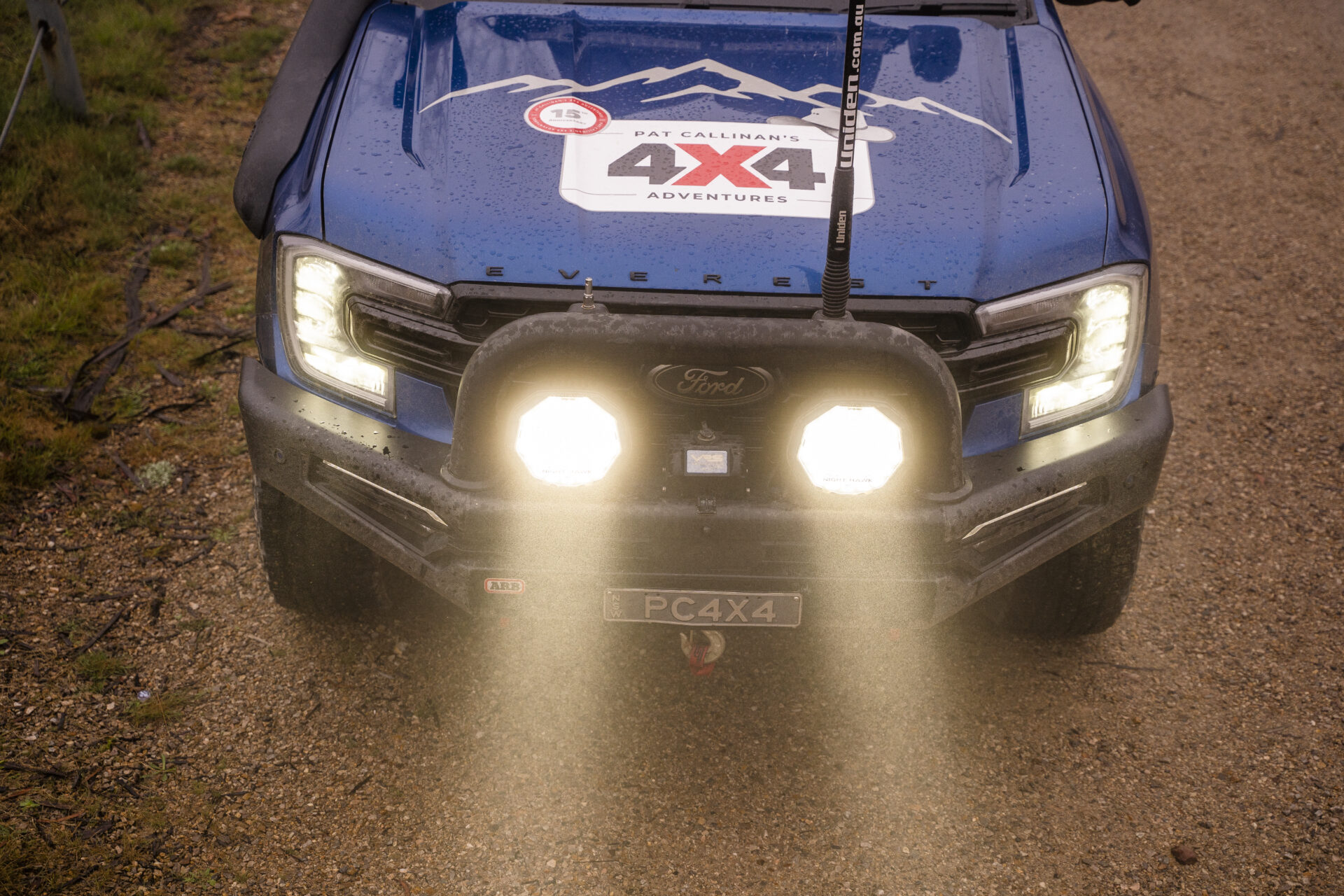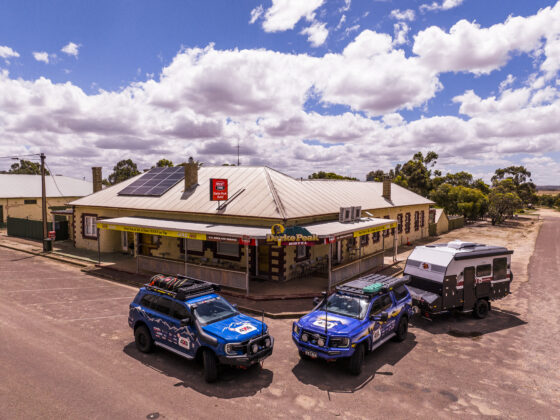With so many marketing buzzwords floating around purchasing a set of 4X4 driving lights can be as tricky as navigating a rutted track, well, in the dark. With a plethora of options and technical jargon thrown into the mix, figuring out the best setup for your beast can get downright confusing. What’s the difference between lumens and lux? How does colour temperature affect visibility in fog? And what about the resilience of your lights against dust and water? Whether you’re a seasoned 4X4er or gearing up for your first off-road adventure, understanding these terms and choosing the right lights are crucial for a safe and successful adventure.
We’ve roped in the experts behind the Night Hawk range of driving lights to help us demystify the specs and features of driving lights—breaking down everything from beam patterns and mounting options to durability and weather resistance—ensuring you know exactly what you’re looking at on the box and what it means for your off-road experiences, after all, why exactly does Pat’s F-150 have lights that can change colour? Let’s shed some light on the subject and get you ready to hit the tracks with confidence!
Lux V Lumen, what does it all mean?
When you’re in the market for some ripper 4X4 driving lights, you’re going to bump into terms like “Lumen” and “Lux” quite a bit. Think of Lumen as the total “oomph” coming out of the light. It’s all about the quantity of light produced, not what’s actually happening with it. So, a higher Lumen means a brighter light, right out of the gate, but doesn’t necessarily tell you how it’ll relate to your driving experience.
On the flip side, Lux gets a bit more finicky. It cares about where that light goes. Lux measures the amount of light hitting the spot you’re aiming at, technically speaking, it’s 1 Lumen per square metre. It’s all about the concentration of light in a specific area. So, while Lumens tell you how bright your light is, Lux tells you how well that brightness is used on the road ahead. You’ll typically see that figure with a distance attached to it. The Night Hawk VCTs (Variable Colour Temperature) fitted on Pat’s F-150 boast 1 Lux @ 974m. That means the lights are effective out to that range, but the Night Hawk VLIs (Variable Light Intensity) which boast 1 Lux @ 1486m may be more suitable for someone who does a lot of high-speed outback driving.

Colour temperature made easy
Another critical piece of the puzzle is the colour temperature, measured in Kelvin (K). This isn’t about how hot the light gets, but rather the colour of the light emitted. Picture it this way: lower Kelvin numbers give you a warmer, yellower light, like the cozy glow of a campfire. Higher Kelvin values, on the other hand, produce a cooler, bluer light, similar to a bright, sunny day at the beach.
Now, why does this matter for your 4X4? Well, warmer lights (around 3000K) are ace for cutting through fog, dust, and rain, making them top-notch for rough weather driving. They’re easier on the eyes during long nighttime drives in the bush, reducing glare and improving visibility in challenging conditions.
Cooler lights, ranging up near 6000K, are brilliant for clarity and contrast. They’re the go-to for illuminating the road or track ahead with a daylight-like quality, making obstacles and track conditions pop. This makes them a solid choice for general driving and especially useful in clear conditions, where you want to spot wildlife or hazards from a fair way off.
Choosing between the two boils down to where and how you plan to use your 4X4. If you’re tackling foggy mountain passes or stormy coastal tracks, the warmth of a lower Kelvin light can be your best mate. But, for clear night driving where sharpness and detail matter, the cooler, higher Kelvin lights shine brightest. This is where those VCT Night Hawk lights on the F-150 really…erm… shine. While the VLI does push further, they’re locked in at 5700K, the VCT option though is variable from 3000K-6000K depending on the terrain Pat’s in.

Spot V Spread, what’s right for you?
Now while beam pattern is one of the simplest to understand concepts, it’s worth talking about regardless so you’ve got a full understanding in one place of what exactly will suit your needs, and what you can live without.
Spot beams are like the focused, intense mate who zeroes in on a task without getting distracted. They produce a narrow, concentrated beam of light that can travel a long distance ahead of your vehicle. This makes them fantastic for high-speed driving on open roads or tracks where seeing far ahead is crucial for spotting roos, wombats, or other hazards well in advance. The spot beam is your go-to for clarity and detail when you’re moving at pace and need to see way down the track, but you’ll generally lose width as a result.
Spread beams, on the other hand, are the sociable, wide-reaching types. They cover a broad area with light, illuminating the sides of the track and the immediate vicinity in front of the vehicle. This is brilliant for slow-speed technical driving, like negotiating tricky bush tracks, where you need a good view of your immediate surroundings to spot obstacles, side paths, or pesky branches. The spread beam ensures you’re not left in the dark about what’s happening around your 4X4.
“Different driving conditions and times of day call for different lighting strategies”
Now, why might you want to switch between these two? Well, it’s like having the right tool for the job. Different driving conditions and times of day call for different lighting strategies. For those long stretches of deserted outback highway, a spot beam will keep you safely in the know about what’s ahead. When you’re weaving through a dense forest track under the stars, a spread beam will help you avoid unexpected guests and keep your paintwork scratch-free.
This is one area that’ll you do get a little flexibility. The Night Hawk VBP (Variable Beam Pattern) offerings allow you to dial between the two settings giving up to 939m in distance and 75m in width in spot mode, or 512m in distance and 164m in width in spread mode. It’s worth mentioning too that clip on covers can help modify your light output too. Throwing a set of flood covers on the VLI model will get you similar results to the VBP model, but not at the twist of a dial.

How to make sure they’ll last
Whether you’re punting around the local tracks or heading off for the trip of a lifetime, it’s important to know the driving lights you buy will work when you need them to. Here’s what you should prioritize in terms of durability and weather resistance to ensure your lights keep shining bright, no matter where the trail takes you.
Water and Dust Resistance: Look for lights rated with a high Ingress Protection (IP) code. This rating indicates the level of sealing effectiveness of electrical enclosures against intrusion from foreign bodies (like dust and dirt) and moisture. An IP rating of IP67 or higher is ideal for off-road conditions, as it means the lights are dust-tight and can withstand temporary immersion in water. By preventing moisture and fine particles from entering the light’s internal components, these features protect against corrosion, electrical shorts, and other damage that can lead to premature failure.
Shock and Vibration Resistance: 4X4ing is synonymous with bumps and jolts. Select lights designed to absorb shocks and resist vibrations. This typically involves robust housing materials and secure mounting systems that minimize the risk of damage or beam misalignment. Driving lights designed to handle shocks and vibrations will maintain integrity and functionality in challenging environments. This not only prevents physical damage but also ensures that the light continues to perform effectively, maintaining beam consistency and reliability.
“This not only prevents physical damage but also ensures that the light continues to perform effectively”
Thermal Management: Efficient heat dissipation extends the life of driving lights by preventing overheating. Features like aluminium housings and heat sinks are crucial for maintaining optimal operating temperatures.
Build Material: The construction materials of the lights play a significant role in their durability. Aluminium is commonly used for its light weight, strong corrosion resistance, and excellent heat dissipation properties. Stainless steel is also favoured for its superior strength and corrosion resistance. These materials ensure that the light housing remains secure and functional despite exposure to elements and rough use.
Seals and Gaskets: Quality seals and gaskets are critical for maintaining the water and dust resistance of the lights. They need to remain elastic and effective over time, even under exposure to extreme temperatures and environmental conditions.
Coatings and Finishes: Protective coatings and finishes enhance resistance to the elements. UV-resistant coatings help prevent cracking or fading of lens covers, while anti-corrosion coatings protect metal components from rust and degradation.
Final thoughts
When selecting driving lights, also consider the warranty and support offered by the manufacturer. A good warranty not only indicates the manufacturer’s confidence in their product but also provides peace of mind, knowing that you can get support and replacements if your lights suffer from defects or premature failure. Fly-by-night companies often boast good spec’s, but with a 5-year warranty we’re confident the Night Hawk offerings will last the distance.













